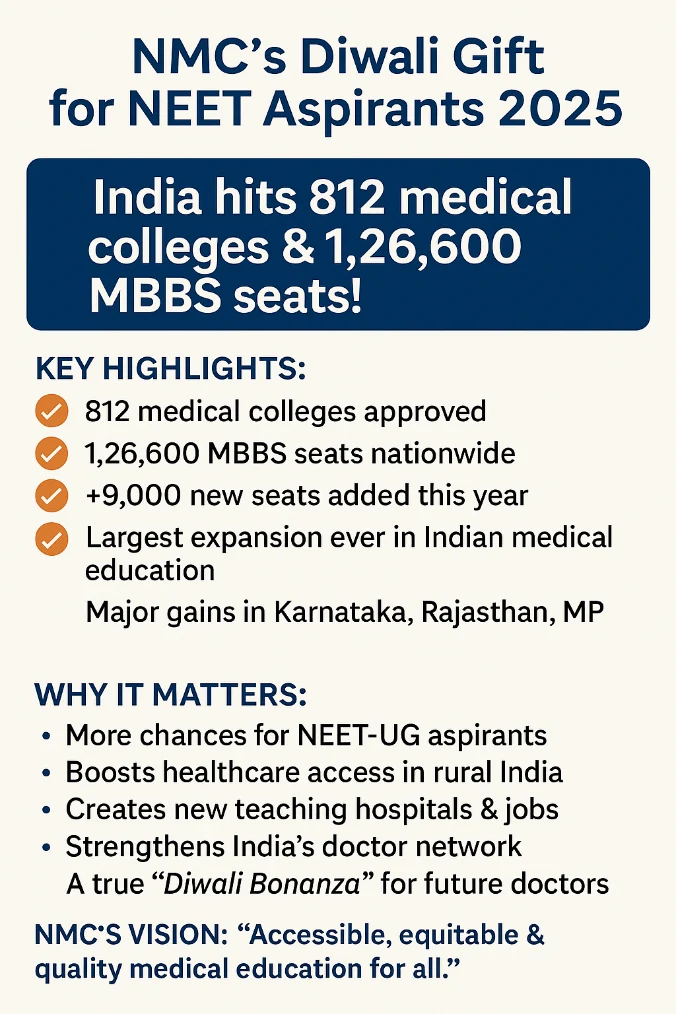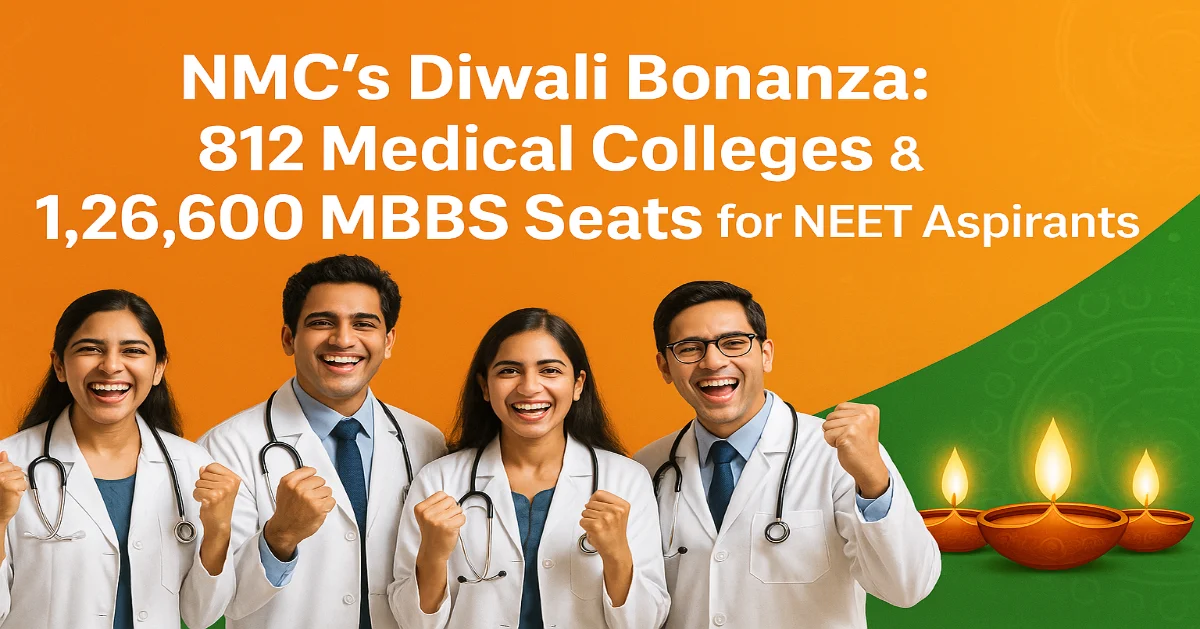In a major development for India’s medical education landscape, the National Medical Commission (NMC) has announced a record expansion of MBBS capacity, marking a festive-season bonanza for NEET-UG aspirants. With 812 medical colleges and 1,26,600 MBBS seats now approved across the country, the 2025 academic session is set to be one of the most inclusive and opportunity-rich years in India’s medical admission history.
This expansion adding over 9,000 new seats while phasing out a few hundred due to compliance and infrastructure reasons has been widely celebrated as a “Diwali gift” for thousands of NEET students who aspire to wear the white coat.
Official Statement
An NMC spokesperson stated:
“The increase in MBBS seats reflects our vision to make medical education inclusive, accessible, and equitable. India needs not just more doctors, but well-trained doctors who can serve every part of the country. This expansion strengthens that mission.”

Background and Expansion Overview
The NMC’s latest revision brings India’s total MBBS seat count to an unprecedented 1,26,600, distributed among 812 medical colleges nationwide. The reform includes new approvals, capacity enhancements in existing institutions, and rationalization of underperforming colleges.
This expansion represents one of the largest single-year increases in India’s medical education system. It reflects the government’s strategic intent to make healthcare education more accessible, reduce regional imbalances, and strengthen the national doctor-to-patient ratio over the next decade.
Read Also: NMC Adds 9075 New MBBS Seats, Raises Total to 126600
Why This Expansion Matters
1. Bridging the Doctor Gap
India continues to face a shortfall of medical professionals, particularly in rural and semi-urban regions. Increasing MBBS seats directly contributes to addressing this long-term shortage and improving healthcare access for millions.
2. Boosting Regional Equity
The new colleges and seat expansions have been distributed across multiple states, ensuring that smaller towns and underrepresented regions get better access to medical education and hospital infrastructure.
3. Strengthening Public Health Infrastructure
Every new medical college typically comes with a teaching hospital adding to local healthcare capacity, creating new jobs, and expanding service reach in underserved districts.
4. Reducing Admission Pressure
With NEET-UG witnessing over 24 lakh registrations annually, the seat expansion eases pressure on aspirants. Even those with mid-range ranks now have realistic chances of securing MBBS admission.
5. Aligning with India’s Vision of Universal Health Coverage
The move supports India’s broader healthcare vision by preparing a new generation of medical professionals equipped to meet future health challenges, especially post-pandemic.
Read Also: NMC Updated Seat Matrix 2025: MBBS List Released
State-Wise Highlights
- Karnataka witnessed a notable rise in MBBS capacity, cementing its position as a top medical education hub.
- Rajasthan added new government medical colleges in Jaisalmer and Tonk, expanding opportunities in Western India.
- Madhya Pradesh crossed the 5,000-seat mark with both government and private institutions contributing to growth.
- Odisha introduced new colleges in Phulbani and Talcher, each with 100 MBBS seats.
- West Bengal saw several colleges enhance their seat capacity from 100 to 150, expanding opportunities in the eastern region.
This balanced distribution demonstrates a conscious effort to decentralize medical education and create regional centres of excellence.
Implications for Stakeholders
For Students
- Increased opportunities mean more realistic chances of admission, even for mid-tier NEET scorers.
- Students must stay updated during counselling rounds to include newly approved colleges in their preference lists.
- Candidates should also verify infrastructure, hospital facilities, and accreditation before finalizing admissions.
Read Also: India’s Medical Education Revolution: NMC Reforms, CBME, NEXT & More
For Colleges
- Institutions will need to ensure adequate faculty, lab facilities, and hospital beds to maintain standards.
- Rapid expansion also demands strong academic governance and quality control to avoid future seat withdrawals.
For the Healthcare System
- Over time, this move will strengthen the nation’s healthcare backbone, ensuring better doctor distribution and service availability.
- However, mere numerical expansion is not enough sustained focus on quality, specialization, and retention will determine true impact.
Challenges Ahead
While the expansion is a welcome reform, it brings logistical and operational challenges:
- Ensuring qualified faculty recruitment and retention.
- Maintaining infrastructure standards in newly approved colleges.
- Preventing dilution of academic and clinical quality amid rapid scale-up.
- Strengthening regulatory inspections to ensure compliance year after year.
Effective oversight by the NMC and coordination with state health departments will be crucial for sustaining this growth without compromising educational standards.
Read Also: NMC Diwali Gift 2025: Record MBBS Seat Increase Brings Hope for NEET UG Aspirants

